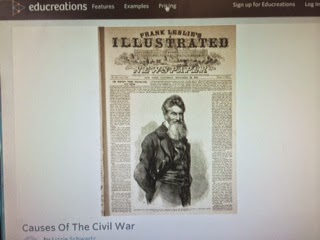Today slavery
is studied by nearly every student in the US so that they will learn never to
repeat this awful action of dehumanization. During the early 19th
century, the topic of slavery was pushed aside, ignored, and avoided so that
white Americans could benefit from it. In Honors History 10, we’ve spent the
past week taking notes, watching videos, and reading primary sources in order
to get a better understanding of what really went down. After that we split into groups and organized the events we had just learned about on a timeline- the conclusion has
become obvious. Through exploration of the Gadsden Purchase, Bleeding Kansas,
the caning of Sumner, and John Brown’s Raid, it becomes clear that the debate
over slavery was the elephant in the room, the obvious issue that nobody wanted
to talk about, for American politics in the early 19th century.
The Gadsden
Purchase was a tiny piece of land bought by the US in 1853, which would be used
to transfer pro slavery settlers to Nevada, California, Utah, Arizona, and New
Mexico. The initial purchase of these states was $15 million, but the tiny
Gadsden cist almost just as much-nearly $10 million. This shows that the US was
avoiding an end to slavery, because they were willing to pay such an outrageous
price for a tin strip of land, just so that it could aid the pro-slavery cause.
 |
| We used an app called timeline to organize events from 1850-59. |
A few years
later, in 1856, an event called “Bleeding Kansas” takes place and is followed
by the caning of an anti-slavery senator, which further proves that American
politicians wanted to avoid the topic of slavery. With turmoil between
anti-slavery “free soilers” and pro-slavery activists, Senator Charles Sumner
gives a speech attacking southerners for forcing slavery on the territory.
Riled up and angry by Sumner’s speech, Representative Preston Brooks “defends”
the south, and their right to slavery, by beating Sumner with his can.
Following the caning, Brooks receives canes in the mail with encouragement to
“beat him again”. The southern, pro-slavery government and people support
Brooks because he punished Sumner for trying to bring the issue of slavery to
attention.
 |
| For each event we wrote out a brief and easily comprehensive summary. |
Even when
activists like John Brown attempted to bring the horrors of slavery to
attention, they were shut down by people in power. In 1859, John Brown raided
the federal arsenal at Harper’s ferry with 21 other individuals, black and
white alike. Quickly, he was captured, tried, and hung, but his last address to
the court stuck out. Brown declared that he would forfeit his life for justice
among all. Nonetheless, the court used his hanging to make a statement- they
would not tolerate anti-slave movements.
Check out this wordle made from Charles Sumner's speech, "The Crime Against Kansas". The bigger the word, the more often it was used in his speech. Its interesting to note that words like "South" and "Now" stick out. While there was slavery in the North, there was less of it. Sumner wanted to bring to attention this issue, and to bring slavery to an end "NOW".





